언청이와 구개 파열(구개 열) Cleft lip(s) and cleft palate(s)

사진 184.좌 토순과 구개파열(구개 열).
Copyright ⓒ 2011 John Sangwon Lee, MD., FAAP
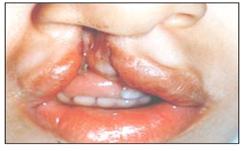
사진 185. 우 토순과 구개파열(구개 열).
Copyright ⓒ 2011 John Sangwon Lee, MD., FAAP

그림 186. 오른 쪽 윗입술의 일부에 생긴 토순
출처; Used with permission from Ross Lab. Columbus. Ohio.
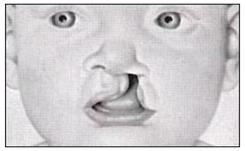
그림 187. 좌 상 입술과 좌 코밑 부위에 생긴 토순
출처; Used with permission from Ross Lab. Columbus. Ohio.
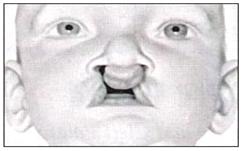
그림 188. 인중의 양쪽 윗입술과 양쪽 코밑 입술에 생긴 토순
출처; Used with permission from 소아가정간호 백과와 Ross Lab. Columbus. Ohio.

그림 189. 연구개에 생긴 구개 파열(구개 열)
출처; Used with permission from 소아가정간호백과와 Ross Lab. Columbus. Ohio.
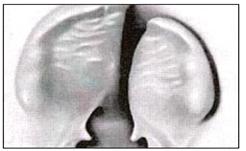
그림 190. 한쪽 경구개, 연구개 전체가 심하게 파열된 구개 파열(구개 열)
출처; Used with permission from 소아가정간호백과와 Ross Lab. Columbus. Ohio.
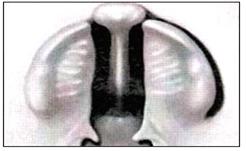
그림 191. 양쪽 경구개와 연구개가 심하게 파열된 구개 파열(구개 열)
출처; Used with permission from 소아가정간호백과와 Ross Lab. Columbus. Ohio
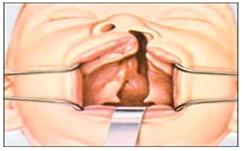
그림 192. 좌 윗입술과 좌 경․연구개가 파열된 토순과 구개 파열(구개 열)
출처; Used with permission from 소아가정간호백과와 Ross Lab. Columbus. Ohio.
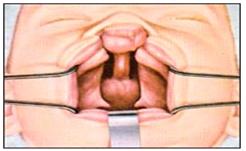
그림 193. 양쪽 윗입술과 구개가 파열된 토순과 구개 파열(구개 열)
출처; Used with permission from 소아가정간호백과와 Ross Lab. Columbus. Ohio.
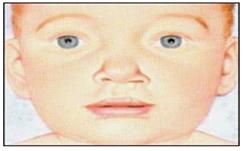
그림 194. 좌 토순을 수술치료 받은 후의 얼굴
출처; Used with permission from 소아가정간호백과와 Ross Lab. Columbus. Ohio.

그림 195. 구개 파열을 수술로 치료 받은 후의 구개
출처; Used with permission from 소아가정간호백과와 Ross Lab. Columbus. Ohio.
언청이와 구개 파열(구개 열)의 원인
-
원인은 아직도 확실히 모르지만 유전으로 생긴다. 한쪽 윗입술 또는 양쪽 윗입술 및, 또는 코밑 부위가 선천적으로 째진 것을 언청이 또는 토순이라고 하고, 입천장이 째진 선천성 기형을 구개 파열(구개 열)이라고 한다.
-
토순과 구개 파열의 크기·모양·정도가 다르다.
-
토순만 있는 기형, 구개 파열만 있는 기형, 토순과 구개 파열이 함께 있는 기형 등 여러 종류의 토순과 구개 열 기형이 있다.
언청이와 구개 파열(구개 열)의 증상 징후
① 인중의 양쪽 윗입술에 금만 조금 가게 째진 토순
② 인중의 한쪽 위 입술에서 그 쪽의 코밑 부위까지 쭉 째진 토순
③ 인중의 양쪽 위 입술에서 양쪽의 코밑 부위까지 쭉 째진 토순
④ 구개 파열과 토순이 함께 있는 선천성 기형도 있고 그의 정도와 크기도 다양하다.
⑤ 토순은 없고 구개 파열만 있는 경우도 있다.
-
구개 파열이나 토순은 유전되는 기형이기 때문에 친 부모·형제·자매들 중 누군가가 구개 파열만, 토순만, 또는 구개 파열과 토순을 동시 가지고 있을 수 있다.
-
구개 파열이 있는 아이에게는 구개 파열 이외 신체 다른 부위에 다른 종류의 선천성 기형이 함께 있을 수 있다.
-
토순과 구개 파열의 정도, 아이의 나이 등에 따라 증상 징후가 다르다.
-
토순과 구개 파열이 함께 생겨 있는 경우가 50%이고, 토순만 있는 경우가 25%, 구개 파열만 있는 경우가 25%이다.
-
토순이나 구개 파열로 미관상 문제가 많이 생긴다. 이 기형을 가진 아이 자신은 물론 부모 형제자매들이 많이 걱정 한다. 심한 토순이나 구개 파열이 있는 영유아는 말 배우는 데도 언어 발육에도 지장이 있다.
-
잇몸도 째지고 이가 고르게 나지 않으며 치열에도 이상이 있을 수 있다.
-
정도에 따라 엄마의 젖꼭지나 젖병 젖꼭지를 적절히 빨 수가 없어 모유 수유하는데 문제가 생길 수 있다.
-
또 인공영양 젖병 젖꼭지로 잘 빨아 먹을 수 없고 먹다가 인공영양이 기도 속으로 흡인되어 쉽게 사레들릴 수 있다.
-
영양실조에 걸릴 수 있다.
-
구개 파열이 있는 영유아는 급성 중이염· 만성 중이염· 재발성 중이염· 삼출성 중이염 등 중이염에 더 잘 걸릴 수 있다. 이런 중이염을 조기에 적절히 치료하지 않으면 난청이 생길 수 있다.[부모도 반의사가 되어야 한다–소아가정간호백과]-제18권 소아청소년 이비인후 질환 참조.
언청이와 구개 파열(구개 열)의 치료
-
토순의 정도, 구개 파열의 정도 및 종류, 토순만 있느냐, 토순과 구개 파열이 함께 있느냐, 또는 신체의 다른 부위에 다른 종류의 선천성 기형이 있느냐에 따라 달리 치료한다.
-
심한 토순이나 구개 파열, 또는 심한 토순과 구개 파열 둘 다 동시 가지고 있는 신생아에게 모유나 인공영양을 먹여서 건강하게 키운다는 것은 여간 힘든 일이 아니다.
-
먹인 모유나 인공영양을 쉽게 구토할 수 있고, 또 구토물이 기도 속으로 쉽게 흡인될 수 있고, 흡인성 폐렴 등이 쉽게 생길 수 있다.
-
신생아기 이후에도 심한 토순이나 구개 파열을 가진 영유아에게 모유나 인공영양, 이유식 등 음식물을 요령껏 먹여야 한다. 이런 기형이 있는 아기들에게 인공영양을 먹이는데 적절하게 만든 특수 플라스틱 젖꼭지도 있다. 심한 토순 및, 또는 구개 파열이 있는 신생아, 영유아에게 엄마의 젖꼭지를 직접 빨아 젖을 먹게 하는 대신 짠 모유나 인공영양을 젖병에 담아서 특수 젖꼭지로 먹일 수 있다.
-
때로는 피딩 관(피딩 튜브/영양 공급관)을 입을 통해 위 속에 넣고, 그 관을 통해 인공영양이나 짠 모유를 먹인다.
-
심한 토순 및, 또는 구개 파열이 있는 신생아, 영유아에게 급성 중이염·만성 중이염·재발성 중이염·삼출성 중이염이 더 잘 생길 수 있다. 그래서 고막에 조그마한 통기 튜브(통기 관)를 설치해 중이염이 생기는 것을 예방 및, 또는 치료도 한다.
-
구개 파열이 있는 신생아, 영유아에게 중이염이나 삼출성 중이염이 있는 것을 잘 모르고 적기에 적절히 치료해 주지 않으면 난청 내지 귀가 먹을 수 있다. [부모도 반의사가 되어야 한다–소아가정간호백과]-제18권 소아청소년 이비인후 질환–구개 파열과 중이염 참조.
-
토순 및, 또는 구개 파열이 있을 때에는 중이염에 걸려 있지 안 했을 때도 이비인후과 전문의의 진찰 진단 치료를 주기적으로 받아야 한다.
-
잇몸이 갈라진 토순이나 구개 파열이 있는 아이의 이가 나기 전에도 치과 전문의의 진단·치료를 조기에 받아야 한다.
-
심한 토순이나 구개 파열이 있는 신생아나 영아가 음식물을 잘 먹고, 정상적으로 성장·발육하고, 건강상태가 전반적으로 양호하면 생후 1∼2개월경에 토순이나 구개 파열을 선택적 수술로 치료해 줄 수 있다.
-
토순만 있든지 또는 구개 파열만 있든지, 두 가지 다 있을 때에는 가능한 한 얼굴 성형수술을 전문하는 전문의로부터 성형수술을 적기에 받는다.
-
또 가능한 한 치과 전문의, 이비인후과 전문의, 언어 교정 전문가, 유전과 전문의, 임상심리사, 소아청소년과 전문의 등 여러 전문의들과 전문가들로 구성된 토순 구개열 치료 팀으로 부터 심한 토순과 구개 파열 기형을 치료받아야 한다.
|
다음은“귀를 만져요, 중이염, 외이도염, 귀지 때문인지요”에 관한 인터넷 소아청소년 건강상담 질의응답의 예 입니다. |
Q&A. 귀를 만져요, 중이염, 외이도염, 귀지 때문인지요
Q.
안녕하세요! 첫 번째 질문입니다.
7개월 된 남아인데요, 한 달 전쯤 아이가 귀를 만지고 잡아 뜯는 것 같아 소아청소년과 에 갔더니 귀에 물이 있대요. 외부에서 들어간 건 아니고요. 며칠 약 먹이니 괜찮대요, 선생님이.
근데 요즘도 가끔씩 귀를 만지작거려요. 가려워 그런가 면봉으로 소지해줘도 역시나고요. 혹.. 벌레나 개미 아닌가 싶어요. 어미로서 시원히 해결 못해줘서 자꾸 안쓰럽기만 하답니다.
두 번째 질문입니다. 땀을 제대로 닦아주질 못해선지 목의 피부색이 누렇게 됐답니다. 목선만 하얗구요. 뽀얗게 돌아올 수는 없는 건가요? 잘생긴 아들 스타일이 영 아니라서요…
A. 민아님
안녕하세요. 질문해 주셔서 감사합니다.
자녀의 나이, 성별, 과거 병력, 가족 병력, 진찰소견, 임상검사 등의 정보를 많이 알수록 답변을 드리는데 도움이 됩니다. 주신 정보를 토대로 해서 답변을 드리겠습니다.
예를 들면 7개월 된 영아의 발가락뼈 골절이 생겨 아프면 그 영아가 골절된 발가락을 손으로 쥐고 거기가 아프다고 부모에게 말할 수 없습니다.
코가 아프다고 손가락으로 코를 가리킬 수 없습니다.
외이도염이나 중이염이 있어 아프더라도 그 귀를 가리키고 아프다는 것을 부모에게 알릴 수 없습니다.
그러나 아무 목적 없이 손이 이마로 코로 귀로 가서 그 부위를 긁거나 만질 수 있습니다. 다시 말씀드리면 7개월 된 아기가 귀에 손을 댄다고 해서 그 귀에 어떤 이상이 있다고 꼭 단정할 수는 없습니다.
■ “외이도 내에(귓구멍 속에) 팔꿈치보다 더 큰 것만 넣어라“
라는 말이 있습니다.
엄마가 영아의 귓구멍을 이경 등으로 진찰하지 않고 그냥 무턱대고 외이도 속을 후벼주다가 고막과 중이에 외상을 입혀 그 후 귀 수술 치료를 몇 번 받았던 아이도 봤습니다.
귓구멍 속을 후벼주지 마시기 바랍니다.
걱정되시면 소아청소년과나 이비인후과에서 진찰 진단을 받고 그에 따라 적절히 치료하시기 바랍니다. 중이염에 관해서는 중이염(p.00)을 참조하시기 바랍니다.
목의 피부색이 변화된 원인은 왜 그런지 확실히 모르겠습니다.
혹시 아토피성 피부염으로 그렇게 변한 것 같습니다. 그렇지 않으면 지루성 피부염으로도 그렇게 피부색이 변할 수 있습니다.
아토피성 피부염이 있는 아이들의 외이도 속에도 아토피성 피부염이 생길 가능성이 많고 아토피성 피부염이 외이도 속에 있으면 귀가 가려워서 자주 긁을 수 있습니다. “귀에 물이 있대요.”에 관해서인데 아마도 중이강 속에 염증이 있었겠고 지금쯤은 치료로 중이 속에 물이 다 없어져서 다 나았을 것입니다. 그렇지 않으면 중이강 속에 삼출액이 있었을지도 모릅니다.
소아청소년과에서 진찰 진단을 해 주시고 중이염이 다 나섯나 확인해 보시고 나머지 문제에 관해서 상담하시기 바랍니다.
[부모도 반의사가 되어야 한다–소아가정간호백과]-제17권 소아청소년 피부질환–아토피성 피부염.
제18권 소아청소년 이비인후 질환–귀지, 외이도염, 중이염 등을 참조하시기 바랍니다.
그리고 질문이 더 있으면 다시 연락해 주시기 바랍니다.
감사합니다. 새해에 건강하시고 복을 많이 받으시고 모든 일이 형통하시기 빕니다. 이상원 드림
|
다음은“정상적으로 자랄까요?, 구개 파열, 심방중격 결손, 폐동맥 협착증 ?”에 관한 인터넷 소아청소년 건강상담 질의응답의 예 입니다. |
Q&A. 정상적으로 자랄까요?, 구개 파열, 심방중격 결손, 폐동맥 협착증 ?
Q.
안녕하세요..저희 애는 만36개월 된 남아입니다. 좀 복잡해서 간단하게 정리 먼저 할게요.
출생 시 4.05kg
생후 3일째 심방중격 결손, 폐동맥 협착 발견 하루 우유섭취량이 100도 안될 정도로 심각해서 입원 수십 차례 후 만 4개월째 심장수술, 한쪽 요관이 2개 발견
음낭수종, BCG 부작용에 의한 혹, 절로 없어짐
만 18개월째 구개열 발견, 22개월 때 수술
구개열로 인한 한쪽 귀 심하지 않은 난청, 언어 평가 8월 검사예정
구개열수술 후, 뭐든지 아주 잘 먹음
고추에서 피가 나와 입원했었으나 우리나라 비뇨기과 명의라는 분이 정확히 밝혀내지 못해 약물로 예방만하고 있음(거의 1년여)
현재 키90cm, 작년 10월 87cm 또래보다 많이 작아 성장호르몬주사를 시도하려고 병원에서 성장속도 체크 중(아빠 174cm,엄마 167cm)
자주 코피를 흘리고 멍이 자주 생겨 혈액검사하였으나 이상 없음, 좀….?
학습능력, 언어구사력 아주 정상
가족 중 선천성 기형 없음
감기를 달고 살아 자주 입원
선생님 저희 애 상태를 자세히 말씀드리고자 이렇게 말 줄여 적은 걸 죄송스럽게 생각합니다. 워낙 예쁘게 생겨 아기 때부터 모델 제의도 들어오던 앤데…
다른 건 몰라도 다른 애들처럼 건강하게만 자라줬으면 좋겠는데 아직도 심장이 완치라고는 볼 수 없어 계속 심장 초음파검사하고 비뇨기과, 성형외과, 소아내분비과…계속 진료 받고 있습니다.
유명한 한의원도 방방곡곡 다녀보고 몸에 좋다는 것도 어떻게든 구해 먹이는데….너무 답답해서요.
A.
나리엄마께
안녕하세요. 질문해 주셔서 감사합니다. 좋은 질문입니다.
답변이 늦어 죄송스럽습니다.
자녀의 나이, 성별, 과거 병력, 가족 병력, 진찰소견, 임상검사 등의 정보를 많이 알수록 답변을 드리는데 도움이 됩니다. 주신 정보를 토대로 해서 답변을 드리겠습니다.
감사드립니다. 부모님으로서 자녀 양육에 최선을 다 하시는 몸과 마음씨가 역력히 보입니다.
그리고 대한민국에 영광과 만세를 올립니다.
너무도 자녀 양육과 교육이 잘 되어 있습니다.
마치 소아청소년과 레지던트가 대학병원에서 아침에 소아청소년과 회진을 돌면서 주임교수에게 자기가 맡은 소아 환아에 관해 보고를 하는 것같이 잘 하셨습니다.
이렇게 건강상 문제가 많이 있는 자녀를 둔 부모들은 어떤 면에서는 전문의보다 더 많은 의학지식을 갖고 있을 때가 많이 있습니다.
더군다나 요즘같이 사이버 시대에는 더 그렇습니다.
부모들이 의사보다도 더 많은 의학 지식을 가질 수 있고 더 최신 의학 정보를 갖고 있다가 우리 의사들을 가르치기도 합니다.
이것도 잘못 된 것이 하나도 없습니다.
특히, 소아들의 병은 의사, 부모, 환자가 한 팀 멤버가 되어 국가와 사회가 치료를 협력해서 함께 해야 훨씬 치료 효과가 좋기 때문입니다.
그래서 어떤 부모는 반의사라기보다 진짜 고명한 전문의가 되고도 남을 정도입니다.
그 동안에 정신적으로 육체적으로 경제적으로 수천 톤이 넘는 무거운 짐을 지고 자녀 양육에 어머니로서 조건 없는 모성애를 그대로 뿌리시고 발휘했던 것이 역역합니다.
앞으로 계속 조건 없는 진정한 사랑을 베풀 수 있는 아기의 어머님께 다시 한 번 경배 드립니다.
어린 자녀가 어떤 기형을 가지고 태어나거나 어디가 아프면 부모들에게 FAGS(Fear, Anger, Guilt, Sad) 증후군이 자연히 생깁니다.
제가 다행히도 예일대학 병원 소아청소년과에 있는 “소아 복합 선천성 기형과 신체장애자 클리닉(Pediatric multiple handicapped clinic)”에서 소아청소년과학을 공부한 적이 있습니다.
거기서 나리 어머님의 자녀의 문제보다도 더 많은 문제를 안고 사는 소아청소년들과 그들의 부모들을 많이 보았습니다.
매주 마다 그 클리닉은 한번 열입니다. 각종 소아 특수 전문의들, 소아 환아들에 관련된 다른 전문과 전문의들, 소아청소년 임상전문가들이 한 날 한 자리에 모여 복합성 천성기형과 신체장애아로 고생하는 소아청소년 환아들의 건강 문제를 필요에 따라 도와줍니다.
많은 소아 환아들과 그들의 부모들이 이 병원 저 병원에 갈 필요가 없었습니다.
사회 복지사는 각 환아의 진료비 및 기본 생활 보장 문제 등에 관해 돌보아줍니다.
소아 영양사는 각 장애아가 필요한 음식물에 관해 돌봐줍니다.
소아 심장과 전문의는 소아 심장 문제를 돌보아주고 소아 이비인후과 전문의와 치과 전문의, 언어교정 전문가는 구개 열에 대한 문제를 한 자리에서 도와주고 소아 내분비과 전문의는 소아 내분비에 관한 문제를 거기서 도와주고 소아 비뇨기과 전문의는 비뇨기 건강문제에 대해 도와줍니다. 이런 식으로 한 클리닉에서 한날 한 곳에서 거의 모든 소아 건강 문제에 관해 도움을 받을 수 있었습니다.
이 얼마나 합리적인 클리닉입니까.
단순한 피 검사를 하고 전화로 그 결과를 알아볼 수 있는 요즘 세상에, 그 검사 결과를 알아보기 위해 만사를 제쳐놓고 강릉에서 서울에 있는 병원까지 가는 건강관리를 한다면 어딘가 불합리한 것입니다.
이런 클리닉이 있으면 참 좋겠지요 없으면 만들어 보십시오.
쓸데없는 말씀을 드리는지 모르지만 미리 양해 부탁드립니다.
자연 유산으로 출생한 아기에게 눈도 코도 없고, 이미 자궁 내에서 사망한 후 태어났어도 그 아기에게 이름을 지어주고 목사와 친지 식구들이 모여 장례식을 올리고 안장 합니다.
“태아가 죽었을 때 부모들의 슬픔과 기도와 장례식“이란 주제로 세미나에 참석했을 때 제가 태어난 이후 사는 동안 저의 주변에 생겼던 소아들의 사망에 관해 여러 가지 것을 생각했습니다.
또 사랑하는 소중한 태아가 사망했을 때의 부모들의 슬픈 마음과 하버드 대학에 다니는 20세 아들이 죽었을 때의 부모들의 슬픈 마음에는 차이가 없다는 말도 그날 들었습니다.
저는 세미나에서 많은 감명을 받고 새로운 것도 많이 배웠습니다.
자식을 조건 없이 사랑하는 어머님 같은 분들께서 장애 자녀들을 돕는데 선두에서 일하시면 참 좋을 것 같습니다.
물론 정상적으로 성장할 수 없고 신체장애가 있는 자녀들에게 그때그때 생기는 건강 상태에 따라 치료 해줄 것을 결정해야할 것입니다.
성장 호르몬 결핍증이 있으면 성장 호르몬으로 치료받아야 합니다. 그러나 지금 그 호르몬 치료를 꼭 받아야 하는지 저는 잘 모르겠습니다.
둘째로 폐동맥 협착증과 심방중격 결손증이 동시 있는 선천성 심장기형은 일종의 전신 청색형 선천성 심장기형에 속합니다.
폐동맥 협착증의 중증도 다를 수 있습니다.
우심방 속 정맥혈이 좌심방 속 동맥혈과 섞일 가능성이 있습니다. 그러면 전신에 저산소혈이 생길 가능성이 있습니다.
심장기형을 응급으로 고쳐주지 않는 한 정상적으로 성장하기가 어려울 수 있습니다.
이런 심장기형은 잘 해결해 주어야 잘 성장할 수 있습니다.
구개 열(구개 파열)이 있는 신생아들, 영유아들에게 중이염이 더 잘 생기고 난청이 생기기가 쉽습니다. 특히 감기에 걸리면 중이염에 걸려 있는지 없는지 꼭 확인하는 것도 대단히 중요합니다.
적절한 시기에 언어교정 치료도 해야 합니다. 폐동맥 협착증이나 심방중격 결손증이 있을 때와 같이 신체의 한 부분에 선천성 기형이 있으면 비뇨기계 등 신체의 다른 계통에도 선천성 기형이 있을 가능성이 있습니다. 그런 기형이 있는지 찾아봐야 합니다. 있으면 고쳐주는 것도 중요합니다.
끝으로 염색체 검사를 하는 것도 좋을 듯합니다.
앞으로 건강히 잘 자라기 빕니다.
언청이와 구개열.
[부모도 반의사가 되어야 한다–소아가정간호백과]-제3권 신생아, 영유아, 학령기와 사춘기 아이들의 성장발육–해당 연령의 성장 발육, 생후 1개월~6세 아이들의 발육 이정표.
제10권 소아청소년 신장 비뇨 생식기계 질환–혈뇨, 이중요관.
제11권 소아청소년 심장 혈관계 질환–심방중격 결손증, 폐동맥협착.
제14권 소아청소년 내분비, 유전, 염색체, 대사, 희귀병–성장지연.
제18권 소아청소년 이비인후 질환–구개 열과 중이염 등을 참조하시기 바랍니다.
질문이 더 있으면 다시 연락해 주시기 바랍니다.감사합니다. 이상원 드림
Cleft lip(s) and cleft palate(s)언청이와 구개 파열(구개 열)

Picture 184. Left labrum and palatal rupture (palatal fissure). Copyright ⓒ 2011 John Sangwon Lee, MD., FAAP

Picture 185. Right cleft lip and cleft palate. Copyright ⓒ 2011 John Sangwon Lee, MD., FAAP

Figure 186. cleft lip on part of the right upper lip; Used with permission from Ross Lab. Columbus. Ohio.

Figure 187. cleft lip on the left upper lip and left lower nose area; Used with permission from Ross Lab. Columbus. Ohio.

Fig. 188. the cleft lip at both side of the Philtrum, on both upper lip ; Used with permission from Encyclopedia of Pediatric and Family Nursing and Ross Lab. Columbus. Ohio.

Figure 189. A cleft palate at the soft palate ; Used with permission from Encyclopedia of Pediatric and Family Nursing and Ross Lab. Columbus. Ohio.

Figure 190. A palatal rupture with severe rupture of the entire soft palate, unilateral hard palate (cleft palate) source; Used with permission from Encyclopedia of Pediatric and Family Nursing and Ross Lab. Columbus. Ohio.

Figure 191. Cleft palate with severe rupture of both hard palate and soft palate (palatal fissure) source; Used with permission from Encyclopedia of Pediatric and Family Nursing and Ross Lab. Columbus. Ohio

Fig. 192. Labial and palatal rupture with ruptured left upper lip and left soft palate ; Used with permission from Encyclopedia of Pediatric and Family Nursing and Ross Lab. Columbus. Ohio.

Figure 193. A ruptured labrum and cleft palate (collapse of the palate) on both sides of the upper lip and palate source; Used with permission from Encyclopedia of Pediatric and Family Nursing and Ross Lab. Columbus. Ohio.

Figure 194. Face after surgical treatment of left Cleft lip
source; Used with permission from Encyclopedia of Pediatric and Family Nursing and Ross Lab. Columbus. Ohio.

Figure 195. The palate after surgical treatment of a cleft palate; Used with permission from Encyclopedia of Pediatric and Family Nursing and Ross Lab. Columbus. Ohio.
Causes of cleft lip and cleft palate
• The cause is still unknown, but it is hereditary. A congenital slit of one upper lip or both upper lip and/or under the nose is called a cleft palate or slit, and a congenital anomaly with a slit of the palate is called a cleft palate.
• The size, shape, and degree of rupture of the effusion and cleft palate are different.
• There are several types of labial and cleft palate anomalies, such as anomaly with labial only, anomaly with only a rupture of the palate, and anomaly with a combination of labrum and rupture of the palate.
Symptoms, signs of a cleft palate and cleft palate
① Tosun with only a small amount of gold on both upper lip of the pharynx
② Tosun slit from the upper lip on one side of the pharynx to the part under the nose on that side
③ Tosun slit from the upper lip on both sides of the pharynx to the part under the nose on both sides
④ There is also a congenital anomaly with cleft palate and vomiting, and its degree and size vary.
⑤ There are cases where there is no vomiting and there is only a rupture of the palate.
• Because cleft palate or labrum is an inherited malformation, one of your biological parents, siblings, or sisters may have cleft palate, cleft palate, or both cleft palate and cleft palate.
• A child with a cleft palate may have other types of congenital anomalies in other parts of the body other than a cleft palate.
• Symptoms vary according to the degree of vomiting and cleft palate, and the age of the child.
• Vomit and cleft palate coexist in 50% of cases, in 25% of cases in which there is only labia, and in 25% of cases in which there is only palatal rupture.
• There are many cosmetic problems due to vomiting or rupture of the palate. The child with this deformity is very concerned about herself as well as her parents, brothers and sisters. Infants with severe vomiting or cleft palate have difficulties in learning to speak and developing language.
• The gums are also cracked, the teeth are not evenly spaced, and there may be abnormalities in the teeth.
• Depending on the severity, the mother’s nipple or bottle nipple may not be sucked properly, which may cause problems with breastfeeding.
• In addition, the artificial nutrition bottle nipple cannot be sucked well, and the artificial nutrition is sucked into the airways while eating, and it can be easily swallowed.
• You can be malnourished.
• Infants with cleft palate are more susceptible to otitis media, including acute otitis media, chronic otitis media, recurrent otitis media, and otitis media with effusion. If such otitis media is not treated early and properly, hearing loss can occur. www.drleepediatrics.com – Refer to Volume 18 Children’s Otolaryngology and Throat Diseases.
Treatment of cleft palate and cleft palate
• Treatment differs depending on the severity of the rupture of the palate, the severity and type of rupture of the palate, the presence of bursitis alone, whether there is rupture of the palpitation and rupture of the palate, or other types of congenital anomalies in other parts of the body.
• It is not difficult to feed a newborn baby who has severe vomiting or ruptured palate, or both severe vomiting and ruptured palate at the same time, by feeding them breast milk or artificial nutrition to raise them healthy.
• You can easily vomit fed breast milk or artificial nutrition, and the vomit can be easily aspirated into the airways, and aspiration pneumonia can easily occur.
• Even after the newborn period, infants with severe vomiting or cleft palate should be fed breast milk, artificial nutrition, and baby food as much as possible. There are also special plastic nipples made suitable for artificial feeding babies with these deformities. Newborns and infants with severe vomiting and/or cleft palate can be fed with special nipples in a bottle instead of directly sucking the mother’s nipple to suckle.
• Sometimes a feeding tube (feeding tube/nutrition tube) is placed through the mouth and into the stomach, through which artificial nutrition or formula is fed.
• Newborns and infants with severe vomiting and/or cleft palate are more likely to develop acute otitis media, chronic otitis media, recurrent otitis media, and otitis media with effusion. Therefore, a small ventilation tube (vent tube) is installed in the eardrum to prevent and/or treat otitis media.
• If a newborn baby or infant with a cleft palate is not aware of the presence of otitis media or otitis media with effusion, and if it is not treated in a timely manner, hearing loss or deafness may occur. www.drleepediatrics.com – Volume 18 Children and Adolescent Otolaryngology – See palatal rupture and otitis media.
• If you have vomiting and/or cleft palate, even if you do not have otitis media, you should receive regular examination and diagnosis from an otolaryngologist.
• Even before teeth appear in children with cracked gums or cleft palate, they should be diagnosed and treated by a dentist early.
• If a newborn or infant with severe vomiting or cleft palate eats well, grows and develops normally, and is in good general health, it can be treated with selective surgery around 1 to 2 months of age.
• Whether you have just a bulge or just a cleft palate, if you have both, get plastic surgery from a specialist who specializes in facial plastic surgery in a timely manner if possible.
• Severe labial and cleft malformations from a labyrinthine cleft treatment team consisting of several specialists and specialists, including dentists, otolaryngologists, orthodontists, geneticists, clinical psychologists, and pediatricians, whenever possible. should be treated
The following is an example of Internet pediatric health counseling
Q&A
regarding “to touch my ear, is it due to otitis media, otitis externa, or earwax?”
Q&A. Touch the ear, is it because of otitis media, otitis externa, or earwax?
Q. Good morning! First question.
He is a 7-month-old boy. About a month ago, I thought the child was touching and plucking his ears, so I went to the pediatrician and he said there was water in his ears. It didn’t come from outside. It’s okay to take medicine for a few days, sir. But even these days, I sometimes fiddle with my ears. It’s itchy, so even if you hold it with a cotton swab, it’s still the same. Or… I don’t think it’s a bug or ant. As a mother, I keep feeling sorry for not being able to solve it coolly. Second question. The skin color of the neck turned yellow because I couldn’t wipe off the sweat properly. Only the neckline is white. Can’t you come back white? Because his handsome son’s style is not young…
A. Minah Good morning. Thanks for asking. The more information you know about your child’s age, gender, past medical history, family history, examination findings, and clinical tests, the more helpful it is to give an answer. We will give you an answer based on the information you provided. For example, if a 7-month-old infant has a fractured toe bone and is painful, the infant cannot hold the fractured toe and tell the parents that it is painful. I can’t point my finger at my nose because it hurts.
Even if you have otitis externa or otitis media, you can’t point your ear and tell your parents that it hurts. However, for no purpose, the hand can go from the forehead to the nose to the ears and scratch or touch the area. Again, just because a 7-month-old baby puts a hand on her ear doesn’t necessarily mean there’s something wrong with that ear.
■ “Put in the ear canal (into the ear canal) only bigger than the elbow”
There is a saying. I have also seen a child whose mother suffered trauma to her eardrum and middle ear while blindly poking through the ear canal without examining the infant’s ear canal with an otoscope, etc., and subsequently received several ear surgeries.
Please don’t poke her in her ear canal. If you are concerned, please visit the Department of Pediatrics or Otolaryngology for a diagnosis and treatment accordingly. For otitis media, see Otitis Media .
I’m not quite sure what caused the skin color on the neck to change. Maybe it has changed to atopic dermatitis. Otherwise, even with seborrheic dermatitis, the skin color can change like that.
Children with atopic dermatitis are more likely to develop atopic dermatitis in the ear canal, and if atopic dermatitis is in the ear canal, they may scratch their ears frequently because of itchy ears.
As for “there is water in the ear”, there must have been inflammation in the middle ear cavity, and by now the treatment should have cleared up all the water in the middle ear.
Otherwise, there may be effusion in the middle ear cavity. Please make a diagnosis at the Department of Pediatrics, check if there are five or five otitis media, and then consult with us about the rest of the problems.www.drleepediatrics.com-Volume 17 Skin Diseases in Children and Adolescents-Atopic dermatitis. Please refer to Volume 18 Children’s and Adolescent Otolaryngeal Diseases – Earwax, otitis externa, otitis media, etc. And if you have any more questions, please feel free to contact me again.
Thank you. I wish you all good health and happiness in the new year, and everything goes well. Lee Sang-won .MD
- The following is an example of Internet Child and Adolescent Health Counseling Questions and Answers regarding “Will I grow normally?, ruptured palate, atrial septal defect, pulmonary artery stenosis?”
Q&A.
Will I grow up normally, cleft palate, atrial septal defect, pulmonary artery stenosis?
Q. Hello..
My child is a 36 month old boy. It’s a bit complicated, so I’ll keep it simple. 4.05 kg at birth Atrial septal defect and pulmonary artery stenosis were found on the 3rd day of life. The daily intake of milk was so severe that it was less than 100 degrees. After dozens of hospitalizations, 4 months after cardiac surgery, two ureters were found on one side. Hydrocephalus, lump due to BCG side effects, disappearing spontaneously Cleft palate found at 18 months, surgery at 22 months Moderate hearing loss in one ear due to cleft palate, language evaluation scheduled for August After cleft palate surgery, I can eat anything very well. I was hospitalized with blood coming out of the pepper, but a Korean urologist couldn’t find out exactly, so I’m only preventing it with drugs (almost a year) I am currently 90cm tall, and I am 87cm taller than my peers in October last year, so I am checking the growth rate at the hospital to try a growth hormone injection (Dad 174cm, Mom 167cm) I had frequent nosebleeds and frequent bruising, so I did a blood test, but there was nothing wrong…? Learning ability and language proficiency are very normal No congenital anomalies in the family Living with a cold and often hospitalized Sir, I am sorry that I shortened the words to explain our child’s condition in detail. She’s so pretty, she’s been receiving modeling offers since she was a baby… I wish I could grow up healthy like other children, but I still can’t see that my heart is cured, so I continue to do echocardiography, urology, plastic surgery, pediatric endocrinology… I continue to receive treatment. I’ve been to famous oriental clinics all over the place and somehow find something good for my body and feed it….
A.
A. to my mother Good morning. Thanks for asking. That’s a good question. Sorry for the late reply. The more information you know about your child’s age, gender, past medical history, family history, examination findings, and clinical tests, the more helpful it is to give an answer. We will give you an answer based on the information you provided.
Thank you.
As a parent, you can clearly see that they are doing their best to raise their children. And we give glory and long live to the Republic of Korea. They are very well nurtured and educated. It was just like a pediatric resident doing a round of pediatrics in the morning at a university hospital and reporting to the head professor about the pediatric patient he was assigned to. Parents of children with these many health problems often have more medical knowledge than specialists in some ways.
Even more so in today’s cyber age. Parents may have more medical knowledge than doctors, and they have more up-to-date medical information to teach our doctors. There is nothing wrong with this either. In particular, for children’s diseases, doctors, parents, and patients become members of a team, and the country and society must cooperate to treat the disease, because the treatment effect is much better.
That’s why some parents are more than just psychiatrists, but really famous specialists. During that time, I was carrying a heavy burden of thousands of tons mentally, physically, and economically, and as a mother, I spread and exhibited unconditional maternal love as it was in raising my children. I once again pay tribute to the mother of a baby who can continue to give unconditional and true love in the future.
Fear, Anger, Guilt, Sad (FAGS) syndrome occurs naturally in parents when a young child is born with a certain malformation or becomes ill.
Fortunately, I once studied pediatrics at the “Pediatric multiple handicapped clinic” in the Department of Pediatrics at Yale University Hospital. There, I saw a lot of young children and their parents living with more problems than those of Na-ri’s mother’s children.
Every week the clinic is open once. Various pediatric specialists, other specialists and specialists related to pediatric patients, and pediatric clinical experts gather in one place to help children and adolescents suffering from complex congenital malformations and physical disabilities as needed. Many pediatric children and their parents did not have to go from hospital to hospital. Social workers take care of each child’s medical expenses and basic livelihood security issues. A pediatric dietitian takes care of the food needs of each child with a disability. Pediatric cardiologists take care of pediatric heart problems, pediatric otolaryngologists, dentists and orthodontists help with palatal fever in one place, pediatric endocrinologists help with pediatric endocrinology problems, and pediatric urologists Helps with urinary health problems. In this way, I was able to get help for almost all pediatric health problems in one clinic and one place in one day.
What a reasonable clinic. In today’s world where you can do a simple blood test and check the results over the phone, it would be irrational to go to a hospital in Seoul from Gangneung and take care of your health by putting everything aside to check the results of the test. It would be great to have a clinic like this. If not, try making one. I may be speaking useless, but I ask for your understanding in advance.
A baby born through a natural abortion has neither eyes nor a nose, and even if the baby is born after death in the womb, the baby is given a name, and the pastor and relatives and family gather for a funeral and burial.
When I attended a seminar on the topic of “Parents’ Sorrows and Prayers and Funerals when a Fetus Died”, I thought about many things about the deaths of children around me during my life since I was born.
I was also told that day that there is no difference between the sadness of parents when their precious fetus dies, and the sadness of parents when their 20-year-old son, who is attending Harvard University, dies. I was very impressed with the seminar and learned a lot of new things. It would be great if people like mothers who love their children unconditionally work at the forefront of helping children with disabilities.
Of course, you will have to decide what to treat for children who cannot grow normally and have physical disabilities according to their health conditions. If you have growth hormone deficiency, you should be treated with growth hormone. But I’m not sure if I really need that hormone treatment right now. Second, congenital heart anomalies with pulmonary artery stenosis and atrial septal defect are a kind of systemic blue-type congenital heart anomaly. The severity of pulmonary artery stenosis may also vary. It is possible that venous blood in the right atrium mixes with arterial blood in the left atrium. Then there is the possibility of hypoxemia throughout the body.
It can be difficult to grow normally unless the heart deformity is treated urgently. This type of heart malformation can only grow well if it is well resolved. Newborns and young children who have a cleft palate (ruptured palate) are more prone to otitis media and are more prone to hearing loss. It is very important to check whether you have otitis media, especially if you have a cold. Orthodontic treatment should also be given in a timely manner.
If there is a birth defect in one part of the body, such as with pulmonary artery stenosis or atrial septal defect, it is possible that there are also birth defects in other parts of the body, such as the urinary system. We need to find out if there is such an anomaly. It is also important to fix it if there is. Finally, it would be good to do a chromosome test. I wish you good health in the future. cleft palate and cleft palate.
www.drleepediatrics.com – Volume 3 Growth and Development of Newborns, Infants, School-age and Adolescent Children – Growth and development at the appropriate age, a milestone in the development of children aged 1 month to 6 years. Book 10 Kidney and Adolescent Kidney and Urogenital Diseases-Hematuria, Double Ureter. Book 11 Cardiovascular Diseases in Children and Adolescents-Atrial Septal Defect, Pulmonary Artery Stenosis. Book 14 Children and adolescents Endocrine, heredity, chromosomes, metabolism, rare diseases-growth retardation.
Please refer to Volume 18, Children and Adolescents Otolaryngeal Diseases – Cleft palate and otitis media. If you have more questions, please feel free to contact us again. Lee Sang-won.MD
출처 및 참조 문헌 Sources and references
- NelsonTextbook of Pediatrics 22ND Ed
- The Harriet Lane Handbook 22ND Ed
- Growth and development of the children
- Red Book 32nd Ed 2021-2024
- Neonatal Resuscitation, American Academy of Pediatrics
-
drleepediatrics.com제6권 신생아 성장 발육 육아 질병
- www.drleepediatrics.com제7권 소아청소년 감염병
- www.drleepediatrics.com제8권 소아청소년 호흡기 질환
- www.drleepediatrics.com제9권 소아청소년 소화기 질환
- www.drleepediatrics.com제10권. 소아청소년 신장 비뇨 생식기 질환
- www.drleepediatrics.com제11권. 소아청소년 심장 혈관계 질환
- www.drleepediatrics.com제12권. 소아청소년 신경 정신 질환, 행동 수면 문제
- www.drleepediatrics.com제13권. 소아청소년 혈액, 림프, 종양 질환
- www.drleepediatrics.com제14권. 소아청소년 내분비, 유전, 염색체, 대사, 희귀병
- www.drleepediatrics.com제15권. 소아청소년 알레르기, 자가 면역질환
- www.drleepediatrics.com제17권. 소아청소년 피부 질환
- www.drleepediatrics.com제18권. 소아청소년 이비인후(귀 코 인두 후두) 질환
- Red book 29th-31st edition 2021
- Nelson Text Book of Pediatrics 19th — 21st Edition
- The Johns Hopkins Hospital, The Harriet Lane Handbook, 22nd edition
-
Childhood Emergencies in the Office, Hospital and Community, American Academy of Pediatrics
-
Emergency Medical Service for Children, By Ross Lab. May 1989. p.10
-
Emergency care, harvey grant and robert murray
-
Emergency Care Transportation of Sick and Injured American Academy of Orthopaedic Surgeons
-
Emergency Pediatrics A Guide to Ambulatory Care, Roger M. Barkin, Peter Rosen
-
Immediate care of the acutely ill and injured, Hugh E. Stephenson, Jr
-
The Critically Ill Child, Diagnosis and Management, Edited by Clement A. Smith
-
Emergency Medical Services for Children: The Role of the Primary Care Provider, America Academy of Pediatrics
-
Quick Reference To Pediatric Emergencies, Delmer J. Pascoe, M.D., Moses Grossman, M.D. with 26 contributors
-
Manual of Emergency Care
-
응급환자관리 정담미디어
-
소아가정간호백과–부모도 반의사가 되어야 한다, 이상원
-
Neonatal Resuscitation American heart Association
-
Neonatology Jeffrey J.Pomerance, C. Joan Richardson
-
Pediatric Resuscitation Pediatric Clinics of North America, Stephen M. Schexnayder, M.D.
-
Pediatric Critical Care, Pediatric Clinics of North America, James P. Orlowski, M.D.
-
Preparation for Birth. Beverly Savage and Dianna Smith
- Infectious disease of children, Saul Krugman, Samuel L Katz, Ann A. Gershon, Catherine Wilfert
-
The Harriet Lane Handbook 19th Edition
-
소아과학 대한교과서
-
제1권 소아청소년 응급의료 참조문헌과 출처
-
Other
Copyright ⓒ 2015 John Sangwon Lee, MD., FAAP
“부모도 반의사가 되어야 한다”-내용은 여러분들의 의사로부터 얻은 정보와 진료를 대신할 수 없습니다.
“The information contained in this publication should not be used as a substitute for the medical care and advice of your doctor. There may be variations in treatment that your doctor may recommend based on individual facts and circumstances. “Parental education is the best medicine.”